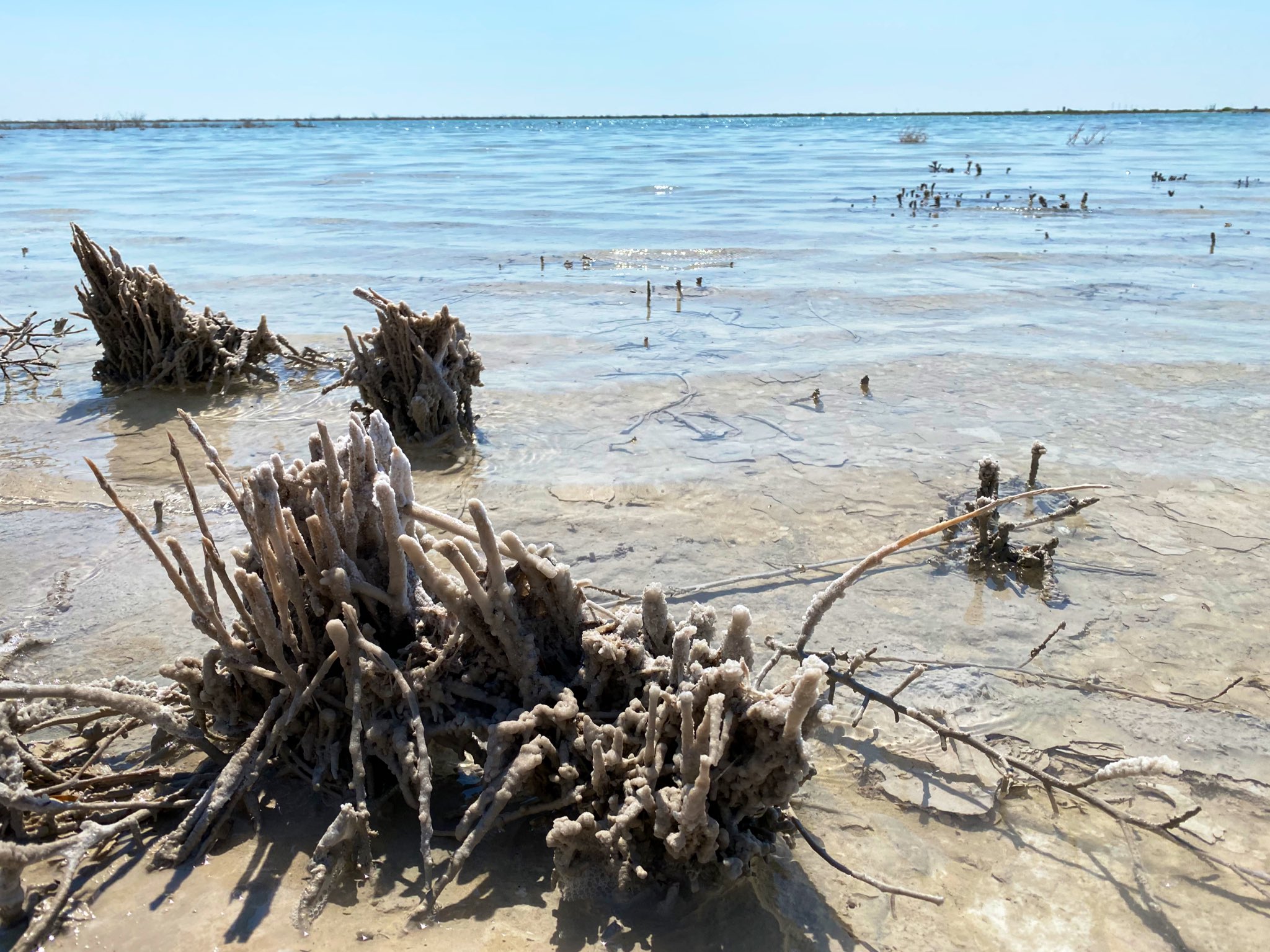About twenty-five miles north of Fort Stockton sits what looks, at first blush, like an oasis amid the West Texas desert. When I recently visited what might be Texas’s newest sizable body of water, its color was a pleasant sea green. A flock of ducks circled in the sky above and landed on the choppy surface.
Yet Lake Boehmer covers more than sixty acres of scrubland with a noxious brew. You wouldn’t want to sate your thirst with its water, which is three times saltier than the ocean, with a sulfate level twenty-five times greater than legally allowed for drinking. Lake Boehmer belches hydrogen sulfide gas, which at low concentrations generates a rotten egg smell and at higher concentrations kills the occasional waterfowl and causes headaches and nausea in humans.
A muddy jetty pokes a couple of dozen feet out into the shallow lake. At its end is a partially submerged cement box around a wellhead. Spouting there is a toxic fountain, a mushroom head of water gushing at two hundred gallons a minute. It first appeared around 2003, though it’s unclear why the water started flowing then, and the lake has been growing ever since. Thanks to bureaucratic buck passing, it shows no sign of stopping.
Lake Boehmer flows from one of several abandoned wells near the tiny community of Imperial. Each of these wells appears to have been drilled in the forties or fifties, when wildcatters were plumbing the area in search of oil. Most of their wells came up dry for petroleum, but produced water of decent quality. Rather than plugging the wells, the oil companies deeded them over to landowners. For a time, they were used to irrigate farms, but most appear to have fallen into disuse in the decades since.
No one is sure who owns the Lake Boehmer well property. Forty different absentee owners have some shares of the various parcels onto which the lake flows, but the Pecos County Appraisal District doesn’t know for sure who owns what. Locals dubbed the body of water Lake Boehmer after a former landowner, Bernard Boehmer. That’s not an official name, but the term has made its way onto Google Maps. The Texas Department of Licensing and Regulation tried in 2005 to track down Bernard Boehmer, but sent a certified letter to an address in “O’Fallow, Missouri.” They likely meant O’Fallon, a St. Louis suburb. There’s no record of whether any other letter was sent, or if it reached him.
[…]
Yet no one has stepped up to plug the well or most of the other abandoned wells in its vicinity. Landowners like Schuyler Wight, a 58-year-old cattle rancher who owns the Santa Rosa ranch across the highway from Lake Boehmer, have been left to go it alone. “The oil company just dumped its liability,” he told me. These wells were drilled 2,600 feet down, much deeper than the typical 200-foot water well. Plugging a well like that is both expensive and tricky.
Wight should know. Earlier this month, he paused an attempt to plug one of these deep wells on his ranch. He spent more than $100,000 and poured at least a thousand sacks of cement into the well, which simply swallowed the cement and kept flowing a couple hundred gallons a minute. Then he ran out of money. “The wells are corroded. They are in very bad shape. There’s collapsed casing, collapsed wellbore, there’s cavities. There’s all kinds of problems,” he said.
Lake Boehmer has been allowed to exist and grow for nearly two decades. The cost of plugging it now is likely far greater than what it would have been in 2003. Makes you wonder what similar problems lie ahead—and who will take responsibility for them—in an aging oil field like the Permian Basin. Neglect is an option, but not a good one.
In addition to the Trib story linked above, a quick Google search found other stories about this ecological hellhole from 2015, 2016, and 2018, plus an interview with this story’s author that followed its publication. (I drafted this in December, so there may be something more recent since then.) The Railroad Commission says it has no jurisdiction, the Texas Water Development Board doesn’t have Lake Bohmer in its database, and for sure no one is ever going to be able to hold those absentee owners or those surely long-gone wildcatter accountable. Hope it doesn’t cause too much more damage in the future, I guess.

